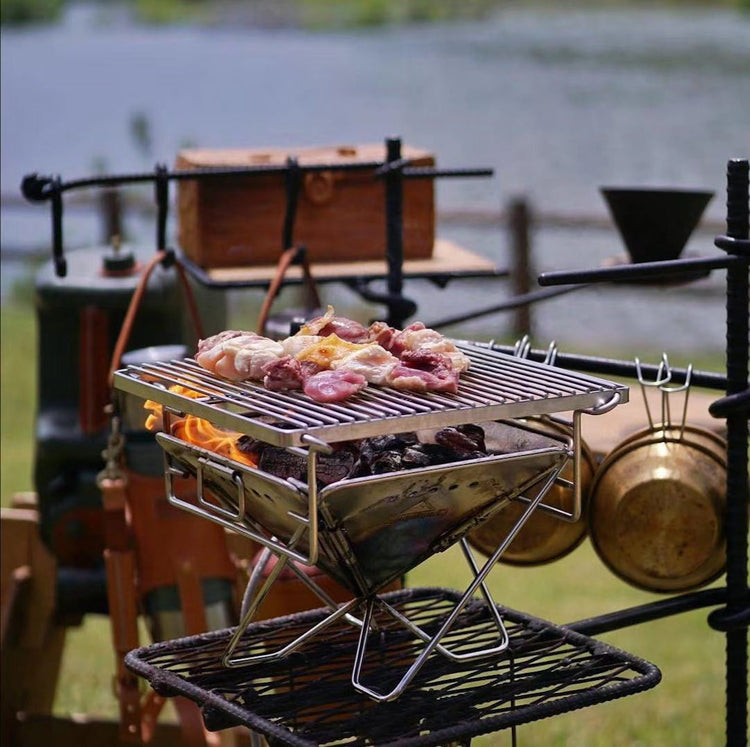Introduction
A fire pit can be a fantastic addition to your camping setup, providing warmth, a place to cook, and an inviting atmosphere for gathering outdoors. However, safety should always be a top priority when building a fire pit. In this guide, we’ll walk you through the essential steps to construct a fire pit safely, ensuring compliance with camping regulations and minimizing environmental impact.
Step 1: Choose a Safe Location
Why It Matters:
-
Prevents accidental fires spreading to nearby vegetation.
-
Ensures compliance with campsite and park regulations.
-
Keeps the fire away from tents and other flammable objects.
Best Practices:
-
Select a spot at least 15 feet away from trees, tents, and structures.
-
Avoid areas with low-hanging branches or dry grass.
-
Choose a level, non-flammable surface like dirt or gravel.
Step 2: Gather Essential Fire Pit Materials
What You’ll Need:
-
Fire ring or metal fire pit (Campingmoon offers durable fire pits for camping).
-
Rocks or bricks to create a sturdy fire boundary.
-
Shovel to clear debris and dig a safe fire pit area.
-
Campingmoon heat-resistant fire mat to protect the ground.
Optional:
-
Campingmoon foldable fire pit grill if you plan to cook over the fire.
-
Windshield or fire screen for added safety in windy conditions.
Alt text: Camping essentials for building a fire pit, including a fire ring and firewood.
Step 3: Prepare the Fire Pit Area
Steps:
-
Clear the Ground: Remove dry leaves, twigs, and debris.
-
Dig a Shallow Pit: About 6-12 inches deep for stability.
-
Lay a Fire-Resistant Base: Use sand, gravel, or a Campingmoon ember mat.
Alt text: A camper preparing the ground for a fire pit by clearing debris and digging a shallow hole.
Step 4: Build a Safe Fire Pit Structure
Methods:
-
Rock Circle: Arrange large rocks around the pit to contain the fire.
-
Metal Fire Ring: Place a Campingmoon fire ring for extra durability.
-
Portable Fire Pit: Use a Campingmoon foldable fire pit for an easy, eco-friendly solution.
Alt text: A properly built fire pit with a stone barrier around the flames.
Step 5: Start the Fire Safely
Safe Fire-Starting Techniques:
-
Use dry wood and kindling for a controlled burn.
-
Avoid flammable liquids (gasoline, alcohol) as they can cause flare-ups.
-
Consider Campingmoon fire starters for an easy and reliable ignition.
Alt text: A camper using a fire starter to safely ignite a small campfire.
Step 6: Monitor and Maintain the Fire
Fire Safety Tips:
-
Keep a bucket of water or sand nearby.
-
Never leave the fire unattended.
-
Use long-handled tools to adjust logs safely.
Alt text: A camper monitoring a fire pit while keeping water nearby for safety.
Step 7: Extinguish the Fire Properly
How to Put Out a Fire Safely:
-
Douse the Fire with Water: Pour slowly, ensuring all embers are soaked.
-
Stir the Ashes: Use a stick or shovel to expose hidden embers.
-
Repeat Until Cold: If the ashes are cool to the touch, the fire is out.
Alt text: A camper pouring water over a fire pit to fully extinguish the flames.
Conclusion
By following these fire pit safety steps, you can enjoy a warm and cozy fire while minimizing risks. Whether you’re setting up a permanent fire pit at home or using a Campingmoon portable fire pit for camping, always prioritize safety and environmental responsibility.


